WASHINGTON –- It was a hot and muggy evening at Fort Clayton, Panama, as then-Pfc. Renae Johnson scanned the jungle tree line in an attempt to stop thieves from gaining entry into the installation.

It was 1992, and Johnson was a member of the Missouri National Guard’s 205th Military Police Battalion. Determined to protect and serve, she enlisted just a year prior at age 17, which landed her a short deployment to support local law enforcement efforts with the 534th MP Company.
A career with the Missouri Guard felt like the right path at the time, or at least that was what Johnson thought until that evening, she said.
“That is when I met my first military working dog (MWD) handler coming out of the jungle,” as she crossed paths with then-Staff Sgt. John McKinney and his narcotics detection dog “Solo 503P” out on patrol, she explained.
McKinney was an imposing figure, standing over 6-feet tall with stacked airborne and air assault badges on his uniform, Johnson said. Solo stood idly beside him and appeared just as large and threatening as his handler.
He stuck around to answer all of Johnson’s questions and even suggested she move to active-duty to pursue a career as a MWD handler, she said.
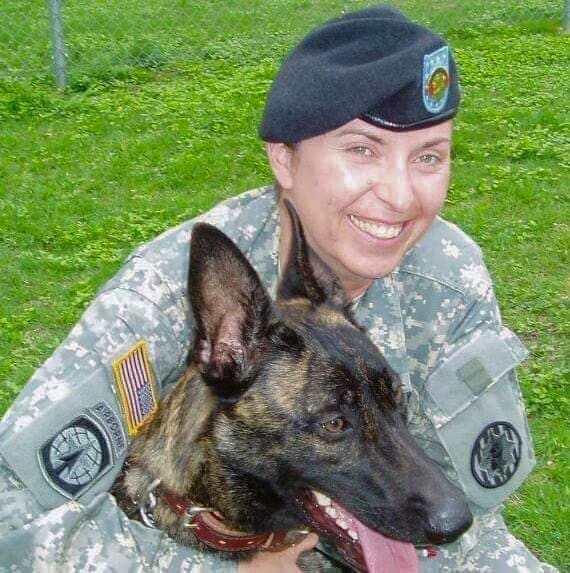
Six months later, she finalized her transition paperwork and moved to active-duty. Johnson would then go on to spend the next seven years, to include multiple deployments and assignments, working toward her goal, she said.
“I just knew it was something I was meant to do,” she said. “Being an MWD handler is an intense and high-impact job — a way of life.”
On Oct. 17, the Military Women’s Memorial unveiled its first monument on the eve of its 23rd anniversary. The memorial honors and tells the stories of women, past and present, who have served the nation.
The monument, titled “The Pledge,” captures a moment of mutual respect and love between a female handler and her Belgian Malinois, said Susan Bahary, its artist.
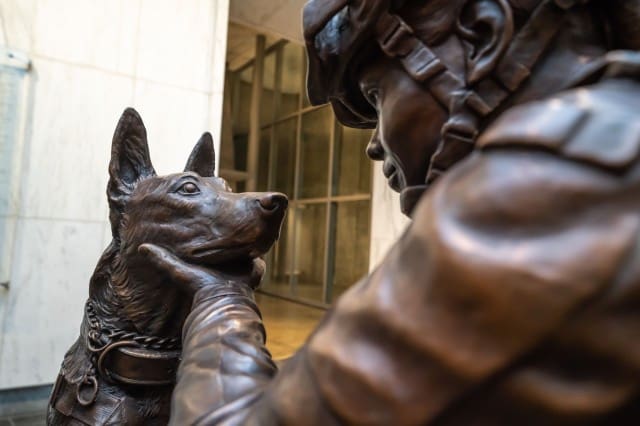
The monument depicts a dog reaching up to her handler as she kneels beside the dog. It captures a feeling of commitment and support, as both reach out to each other with a desire to accomplish their mission, Bahary added.
Johnson proudly served as a handler before retiring in 2012 as a sergeant first class with a military occupational specialty code of 31BZ6, or a MP officer with a working dog additional skill identifier, she said. The Army transitioned to the new 31K MWD handler career field just two years later.
“The job was physically and mentally draining, but none of that mattered if I had my dog beside me,” she said.
As a career handler, Johnson attended the unveiling ceremony with other military handlers. Together, they showed their combined support for their career field and paid respect to the female handlers who helped paved the way, she said.
“It is a beautiful monument that will one day change the trajectory of some little girl’s life,” Johnson said, much like the way her life changed when she first met Solo and McKinney.
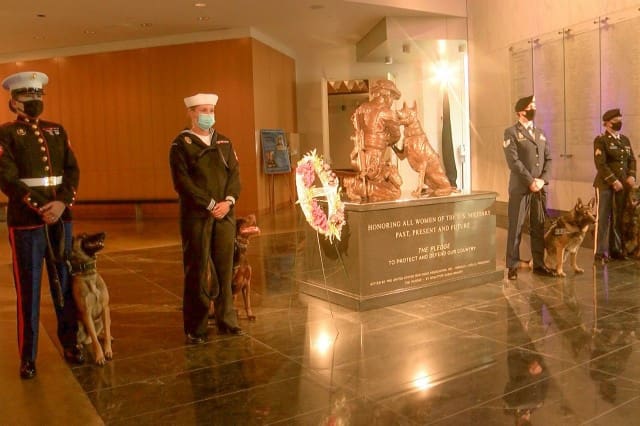
MWD impact
Military working dogs are a force multiplier, often used to provide patrol, narcotics, and explosive detection capabilities in garrison or on the battlefield, said Sgt. Maj. Viridiana Lavalle, the Army’s most senior ranking 31K MWD handler.
These dogs can do “a plethora of things that no piece of equipment or Soldier can emulate … with their sense of hearing, smell and ability to detect,” said Lavalle, who is the provost sergeant major for the directorate of emergency services at Fort Sill, Oklahoma.
Handlers often operate as individual augmentees and can deploy at home or abroad with any unit or agency to provide immediate animal support, she said.
“Dog handlers must be extremely self-sufficient and independent, regardless if they are an 18- or 19-year-old private first class or a seasoned staff sergeant,” Lavalle added.
These Soldiers need to display a high level of maturity and professionalism to find success, she said. Handlers are considered subject-matter experts the moment they arrive and must be able to articulate the limitations and capabilities of the MWD to their chain of command.
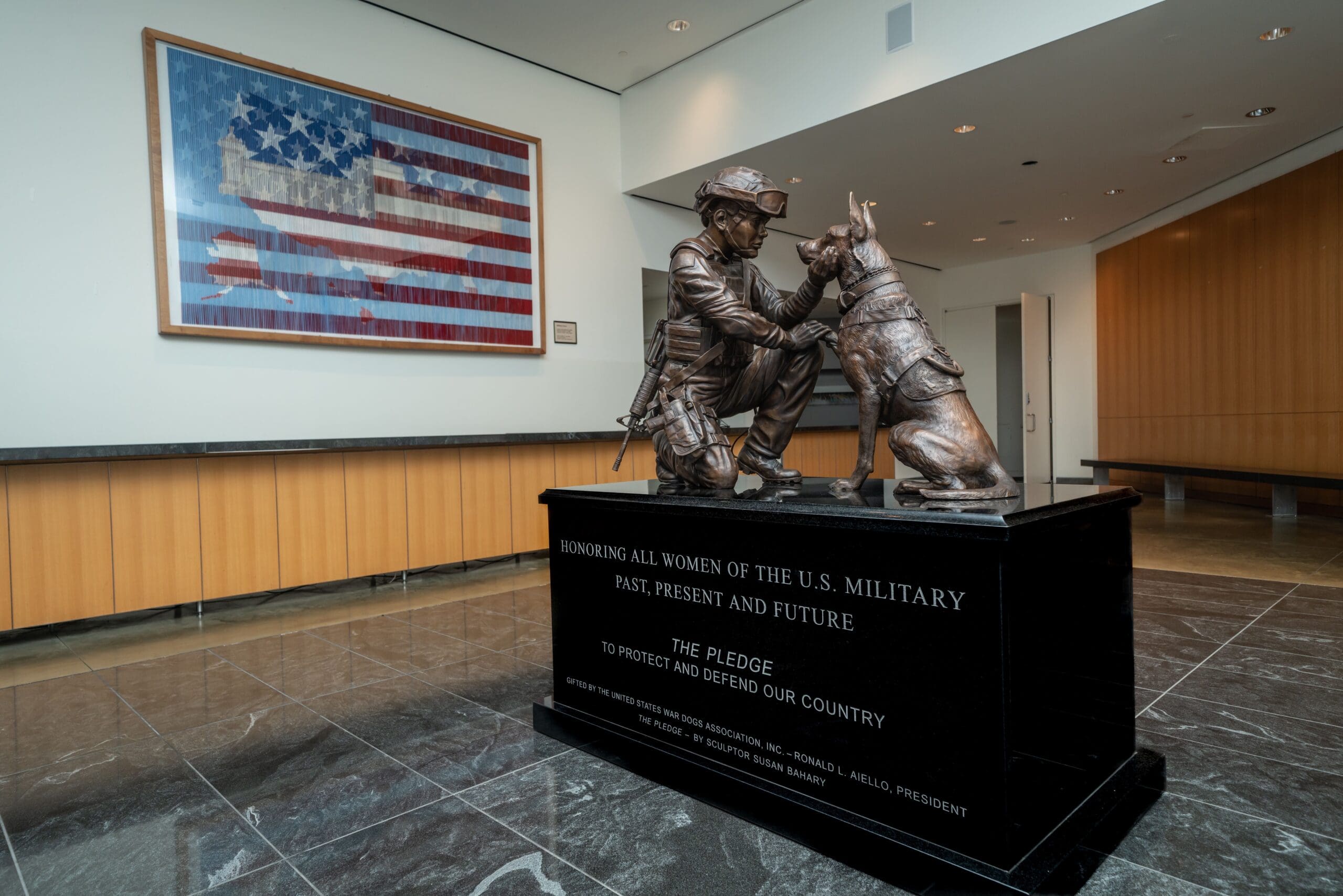
Like Johnson’s experience in Panama, Lavalle’s passion for dogs led her to join the military police corps in 2001 and later transition to a MWD handler in 2003.
“I think we have evolved when it comes to women serving in the MWD MOS,” Lavalle said, adding that more women should choose to serve as a 31K.
The Army currently has close to 650 Soldiers in the MWD field, with nearly 20% of them female, she said.
“We have made a tremendous amount of progress, but we are still facing various obstacles,” Lavalle said. “I have faith we will continue to overcome them and exceed the standards.”
Overall, the MWD career field is one of the best jobs the Army has to offer, she said.
“I can’t even explain how rewarding it is,” Lavalle said. “When you first get your MWD assigned to you and you start to build that bond — then you start to see that team concept.”
Developing trust
Building trust with a K-9 counterpart is a critical aspect of the career field, Johnson said, as she recalled one incident with her explosives detection dog named Fido that warned Soldiers of a possible danger.
While deployed to Iraq, Johnson and another MWD handler joined a quick reaction force to track down an escaped prisoner in a vast junkyard filled with decommissioned Iraqi military equipment and vehicles.
The junkyard spanned across several acres with multiple entry points, Johnson said. Leaders decided to split the handlers into smaller squads and enter the scrapyard on opposing sides to cover more ground.
“I am telling my dog, ‘Find the bad guy,’ as he almost pulls my arm out of the socket,” Johnson said. “We are moving through the junkyard when he starts going crazy and immediately sits down.”
Thinking Fido was just confused by her command, Johnson encouraged him to get back up and continue the search. He pressed forward a little further before deciding to sit once again.
That was when it dawned on her that she recognized her dog’s signal for unexploded ordinances in the area.
Military working dogs are trained to receive praise or reward after completing a task, Johnson explained. An MWD never stops working. In this instance, Fido made the right choice to signal instead of blindly searching the area for the escaped individual.
“I turned around to the squad leader and said, ‘Shut off all your radios, let my dog in front of you and only step where we step.’”
Johnson led the team out of the junkyard and ran around to extract the other squad. The second handler was paired with a narcotics detection dog and was not trained to detect explosives in the area.
“Establishing a bond and rapport is everything to that handler,” Lavalle said. “Without it, that team will not be effective” or could become a liability.
“That is something that we establish from day one when a Soldier goes through dog handling school,” she added. “Understanding the need for a common mutual respect between the dog and handler, and building the rapport and fundamentals during training” is critical to the mission.
The Pledge
Planning for the monument started just under two years ago after the U.S. War Dogs Association commissioned a memorial to honor the service and sacrifice of female MWD handlers, Bahary said.
“With ‘The Pledge,’ we felt it had to represent all women in the military,” Bahary said. “When you can move people emotionally through a work of art, it can open their hearts and make them more apt to learn.”
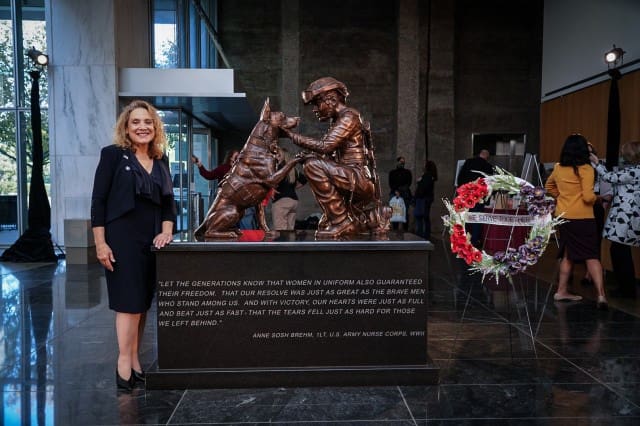
As Bahary started designing the monument, she was determined to convey a strong message of duty, capability, commitment and compassion in both figures. She began by looking at many photos of MWD handlers to draw inspiration for her design.
At one point in the design process, Bahary physically kneeled as if to pose herself in front of a dog sitting with an outstretched paw. Doing so helped ensure a level of authenticity in her final design, she said.
Bahary then went on to start the female figure using a metal armature as a base and covering it with layers upon layers of clay, she said. She then began the sculpting of the military working dog and later added the intricate details of the uniform and equipment.
The model was then cast to create a series of molds, she said. From these molds a multi-step process known as a lost-wax was used to produce a bronze casting of the final figure. The metal process can take two to three months to complete.
The final piece was welded together, the metal was finished, sprayed, and brushed with different chemicals and heated to create color variations. It was then mounted onto a granite base for display at the memorial.
Bahary created the country’s first official war dog memorial, “Always Faithful,” in 1994 to honor all military working dogs killed during service. It was unveiled at the Pentagon and dedicated at the Marine Corps War Dog Cemetery in Guam. It depicts the well-known Marine Corps Doberman named Kurt that fought during the Second Battle of Guam during World War II.
She is also working on the National Service Animals Monument. This monument will be dedicated to the deeds and sacrifices of all animals employed by the military, police, and search and rescue groups, along with the animals providing assistance and companion services or emotional support.
“As an artist, this is an incredible honor,” Bahary said. “It feels so gratifying to know that the women in the military are finally getting this kind of well-deserved recognition in our nation’s capital.”
The Pledge monument is genuinely humbling, Lavalle said, adding that Bahary did a phenomenal job representing all female handlers.
“It is an honor to have the opportunity to be the first female handler to achieve the rank of sergeant major, and to be a part of this era where women handlers are starting to be formally recognized and honored for their sacrifices and commitment to the military working dog program,” Lavalle said.
“As a 31K dog handler, it is my duty and the duty of other women handlers to continue to pave the way,” she added. “This is my passion, and I couldn’t see myself doing anything else. I was born to be a dog handler and trainer.”
By Devon Suits, Army News Service


should honor all the Dogs which the US left behind while fleeing from Vietnam..